Easy Vegan Lemon Asparagus Pasta (One-Pot, 30-Minute Spring Recipe)

As the days grow longer and the first hints of spring fill the air, it’s the perfect time to embrace light, fresh ingredients that capture the season’s essence. Lemon, with its bright, zesty profile, is a star player in spring cooking, adding a burst of citrusy sunshine to everyday meals.
If you’re craving something simple yet sophisticated, this vegan lemon asparagus pasta is your answer. Inspired by classic Italian spaghetti al limone but with a plant-based twist, this dish combines tender spaghetti, crisp asparagus, and a velvety lemon cream sauce that’s both nourishing and indulgent.
Best of all, it’s a one-pot wonder that comes together in just 30 minutes, making it ideal for busy weeknights or casual entertaining. Whether you’re vegan, gluten-free, or just love seasonal eating, this recipe delivers on taste, ease, and health benefits—think vitamin-rich asparagus for immune support and heart-healthy olive oil for a dose of good fats.
Why This Lemon Asparagus Pasta Recipe Works
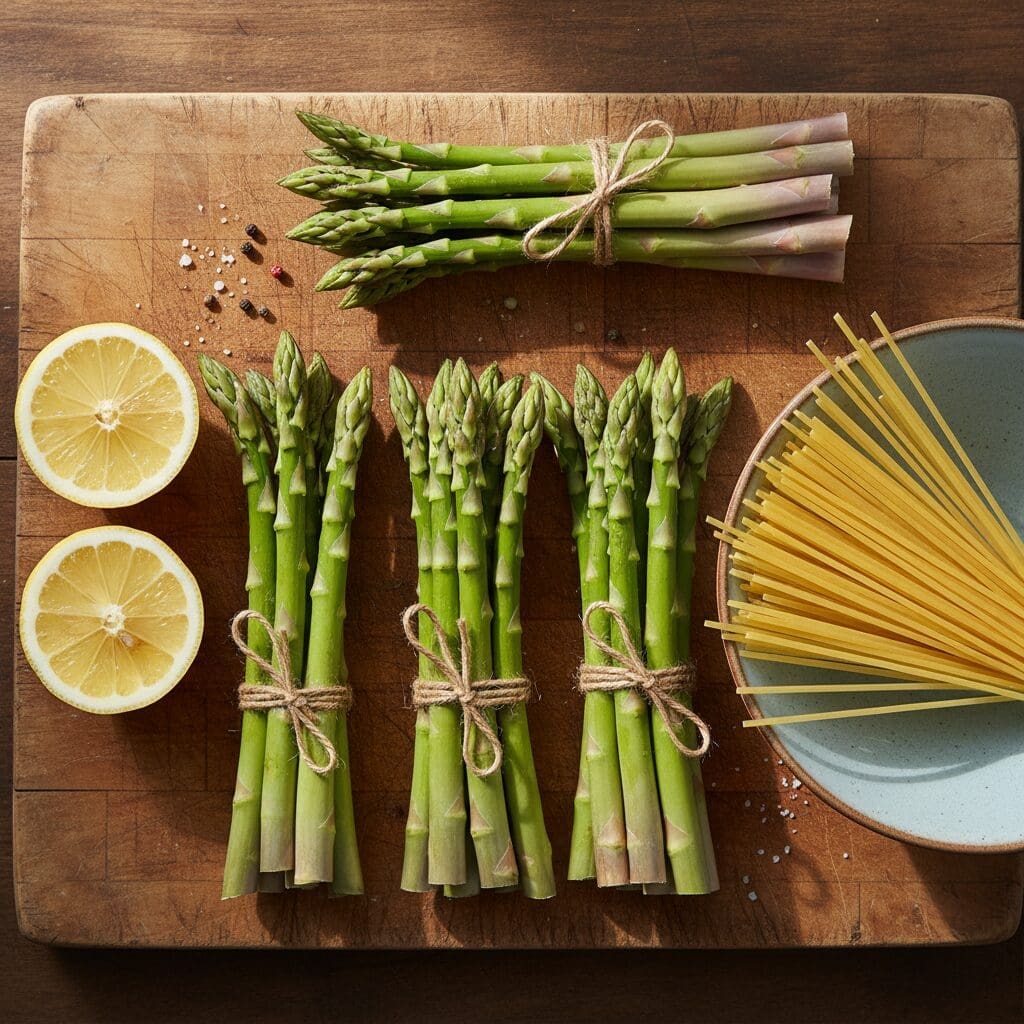
This recipe shines because it balances simplicity with bold flavors, using pantry staples and seasonal produce to create a dish that’s restaurant-worthy without the fuss. The asparagus, at its peak from late spring to summer, provides a satisfying crunch and earthy sweetness that pairs beautifully with the tangy lemon sauce.
By making a quick roux with flour and dairy-free milk, you get that creamy texture without dairy, proving vegan cooking can be just as luxurious. It’s versatile too—easily adapted for dietary needs—and packs a nutritional punch: asparagus is loaded with fiber, folate, and antioxidants, supporting digestion and overall wellness, as noted in a study from the Journal of Food Science.
Plus, the one-pot method means less cleanup, so you spend more time enjoying the meal than washing dishes. For those following plant-based diets, this pasta helps meet protein goals with optional add-ins like white beans, keeping it satisfying and balanced.
Key Ingredients for Vegan Lemon Asparagus Pasta
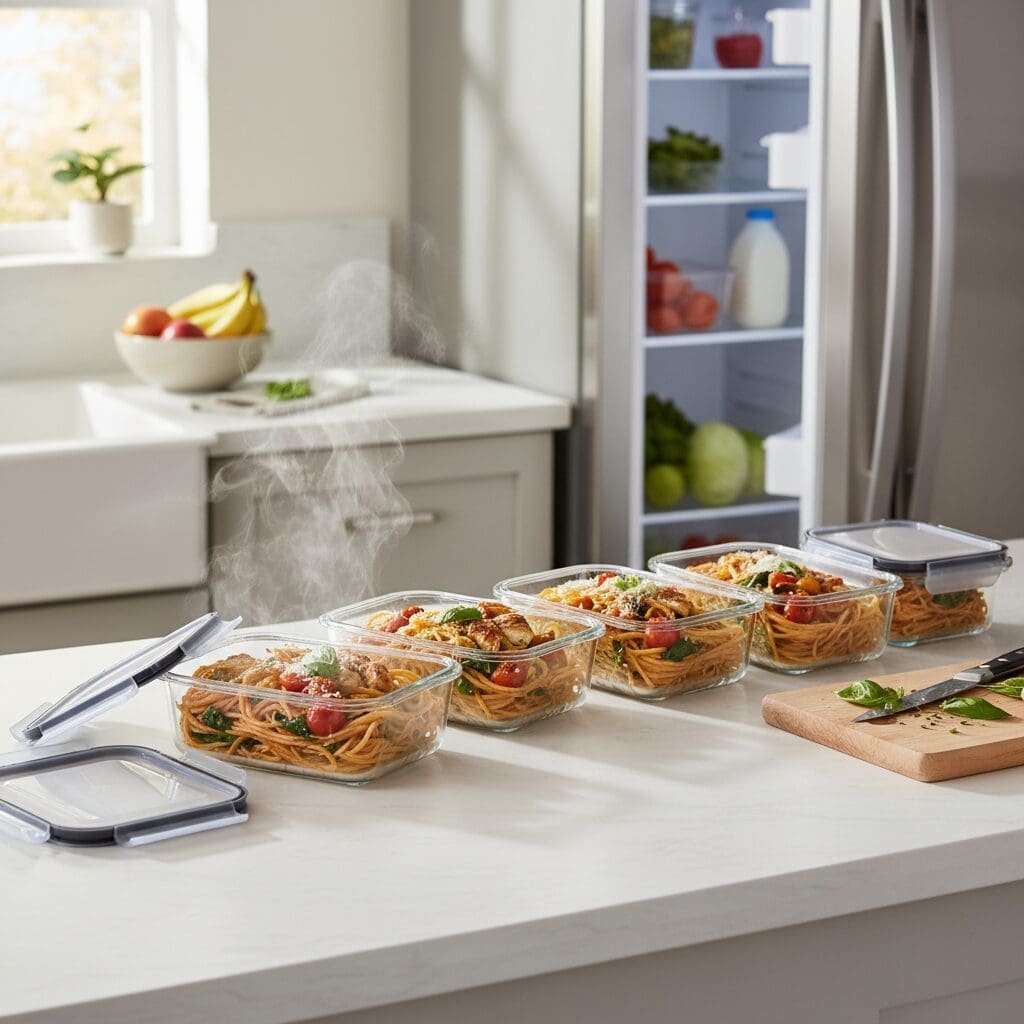
Gathering the right ingredients is key to nailing this recipe’s fresh, vibrant taste. Here’s what you’ll need, with notes on why each matters and smart swaps:
- Pasta (12 oz spaghetti or similar): Opt for long noodles like spaghetti for that classic twirl, but short shapes like penne work too. For gluten-free, choose brown rice or chickpea pasta to keep it hearty.
- Asparagus (1 lb, trimmed and cut into 2-inch pieces): Select firm, bright green spears—avoid limp ones. Trim the woody ends (about 1-1.5 inches) for tenderness. Asparagus is a spring superstar, rich in vitamin K for bone health, according to USDA data.
- Olive oil (4 tbsp): Extra-virgin adds fruity depth and healthy monounsaturated fats that support heart health, as recommended by the American Heart Association.
- Garlic (4 cloves, minced): Fresh garlic infuses aroma and subtle heat.
- All-purpose flour (4 tbsp): Creates a smooth roux to thicken the sauce; use a gluten-free 1:1 blend if needed.
- Dairy-free milk (3 cups, unsweetened cashew or almond): Cashew milk mimics creaminess best due to its natural richness—avoid sweetened varieties to prevent off-flavors.
- Seasonings (1.5 tsp salt, 0.5 tsp black pepper, 0.5 tsp crushed red pepper optional): Adjust to taste for balance.
- Lemons (2, zest and juice): Freshly squeezed is non-negotiable for bright acidity—zest adds oils for extra perfume.
- Fresh parsley (2 tbsp chopped): For a herbaceous finish.
- Vegan parmesan (0.5 cup, optional): Brands like Violife grate like the real thing, or you can make your own with nutritional yeast and nuts.
These components ensure a sauce that’s silky, not watery, and a dish that’s nutrient-dense without being heavy.
Step-by-Step Instructions

Follow these straightforward steps to create your lemon asparagus pasta. Prep time: 10 minutes. Cook time: 20 minutes. Total: 30 minutes. Yields 5 servings.
- Cook the pasta and asparagus: Bring a large pot of salted water to a boil. Add 12 oz spaghetti and cook per package instructions (about 8-10 minutes for al dente). In the last minute, add the chopped asparagus. This quick blanch keeps it crisp-tender. Drain, reserving ½ cup pasta water, and set aside.
- Sauté garlic: In the same pot (or a large skillet), heat 4 tbsp olive oil over medium. Add 4 minced garlic cloves and sauté for 1 minute until fragrant—don’t let it brown to avoid bitterness.
- Make the roux: Sprinkle 4 tbsp flour over the garlic-oil mixture. Whisk constantly for 1 minute to cook out the raw flour taste, forming a smooth paste. This base prevents lumps in the sauce.
- Build the sauce: Gradually whisk in 3 cups dairy-free milk, starting with a splash to loosen, then the rest. Raise heat to medium-high, bring to a simmer, and cook for 2-5 minutes until thickened, stirring often. The sauce should coat the back of a spoon.
- Flavor it up: Remove from heat. Stir in 1.5 tsp salt, ½ tsp pepper, zest and juice of 2 lemons, optional ½ tsp red pepper flakes, 2 tbsp chopped parsley, and ½ cup vegan parmesan. Taste and adjust—more lemon for zing, salt for balance.
- Combine and serve: Add the drained pasta and asparagus to the sauce. Toss to coat evenly. If it’s too thick, add reserved pasta water a tablespoon at a time. Garnish with extra parsley, parmesan, and lemon wedges. Serve immediately for the best texture.
Pro tip: Use a wide pot for even cooking and easy tossing.
Expert Tips for Perfect Results
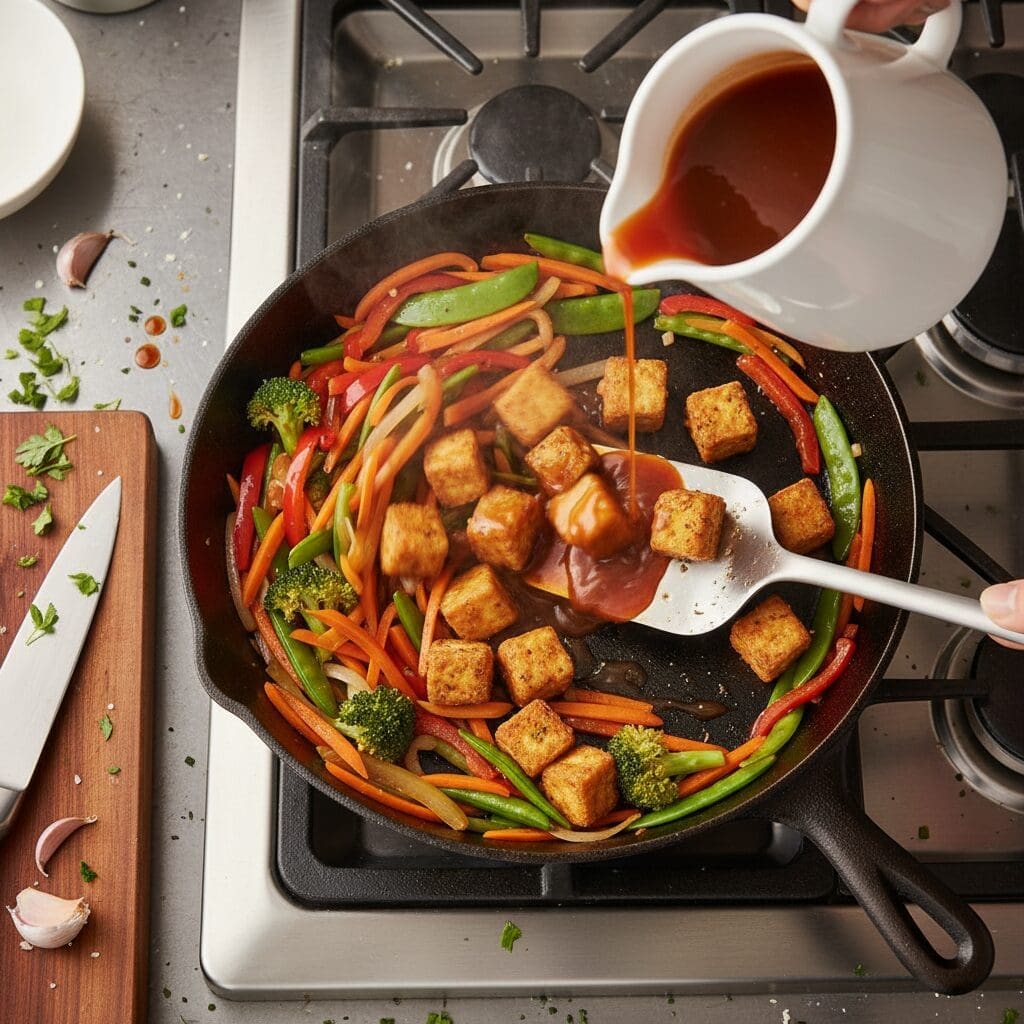
Elevate your pasta game with these insider pointers, drawn from years of vegan recipe testing:
- Choose fresh asparagus wisely: Snap a spear in half—if it breaks cleanly near the base, it’s fresh. For peak flavor, buy local in season; off-season spears can be stringy.
- Master the sauce texture: If your dairy-free milk separates, whisk vigorously or use a blender for homemade versions. Cashew milk yields the creamiest results without gums.
- Prevent overcooking: Test pasta doneness early—al dente holds up better in sauce. Asparagus should be bright green and snappy, not mushy.
- Boost lemon flavor: Zest before juicing to capture the oils. If lemons are tart, balance with a pinch more salt.
- Troubleshoot thickness: Too thin? Simmer longer. Too thick? Pasta water is your friend—its starch helps emulsify.
These tweaks ensure success every time, minimizing common pitfalls like lumpy sauce or bland taste.
Customizations and Variations
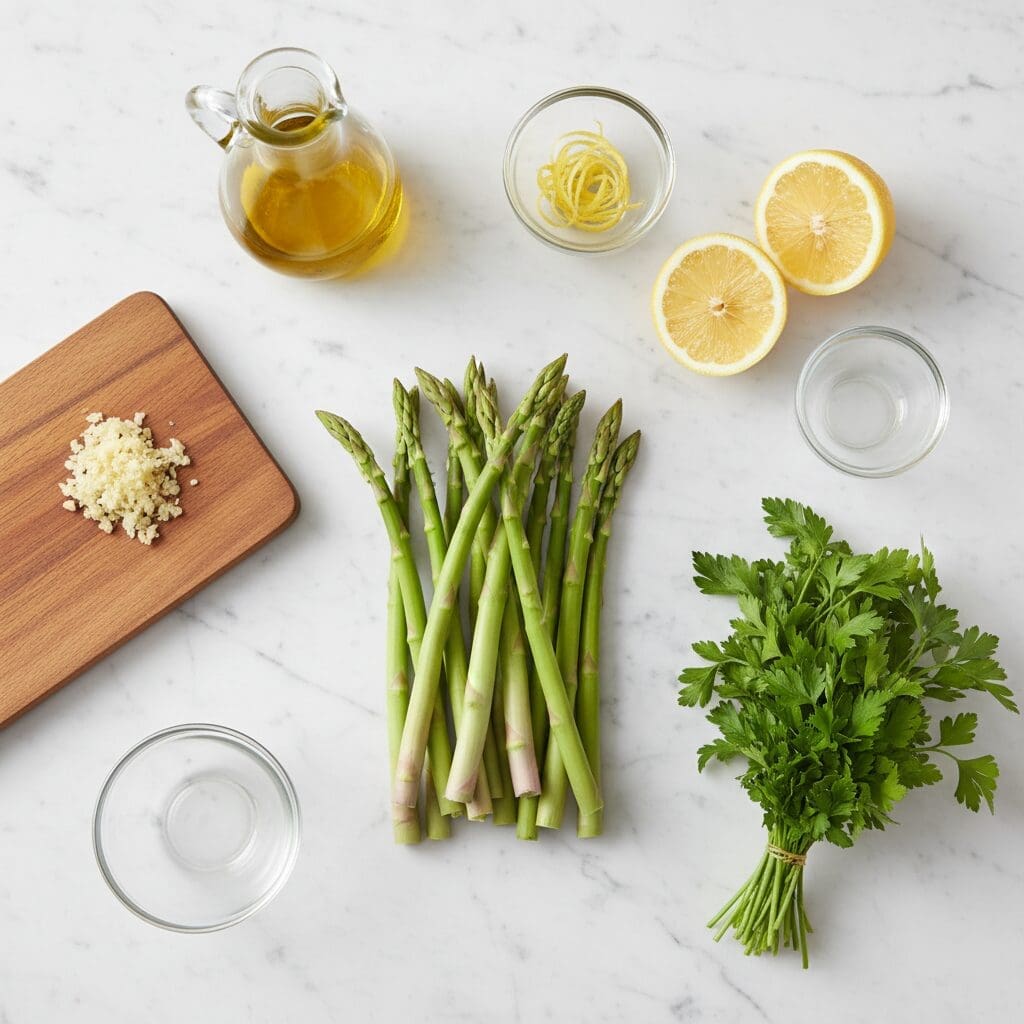
This recipe is flexible to fit your pantry and preferences. Here are easy ways to adapt:
- Gluten-free: Swap regular pasta and flour for gluten-free alternatives—brown rice spaghetti holds sauce well.
- Nut-free: Use soy or oat milk instead of cashew/almond, and skip nut-based parmesan or sub with yeast flakes.
- Veggie swaps: No asparagus? Try broccoli florets, snap peas, or frozen peas—add them in the last 2 minutes of pasta cooking.
- Protein boost: Mix in white beans for fiber-rich heft, or top with crumbled tofu bacon for a carbonara vibe. Seared tempeh strips add chew.
- Spice it up: Double the red pepper for heat, or add fresh basil for herbal notes.
These options keep the dish accessible while allowing personalization, maintaining its quick-prep appeal.
Serving Suggestions and Pairings

Serve this pasta warm as a main for 4-5, or as a side for 6-8. Pair with a fresh lentil salad dressed in vinaigrette to echo the lemon theme, or grilled veggies like zucchini for a full spring spread.
For wine lovers, a Sauvignon Blanc’s acidity complements the citrus—non-alcoholic? Sparkling water with lemon slices.
Kids might enjoy it plain, while adults can add chili oil for kick. Leftovers shine cold in pasta salad form, mixed with cherry tomatoes and olives.
Nutritionally, it offers balanced macros: about 408 calories per serving, 12g protein, 60g carbs, and 14g fat, with asparagus contributing vitamin C for immunity (per NIH guidelines).
Storage, Reheating, and Make-Ahead
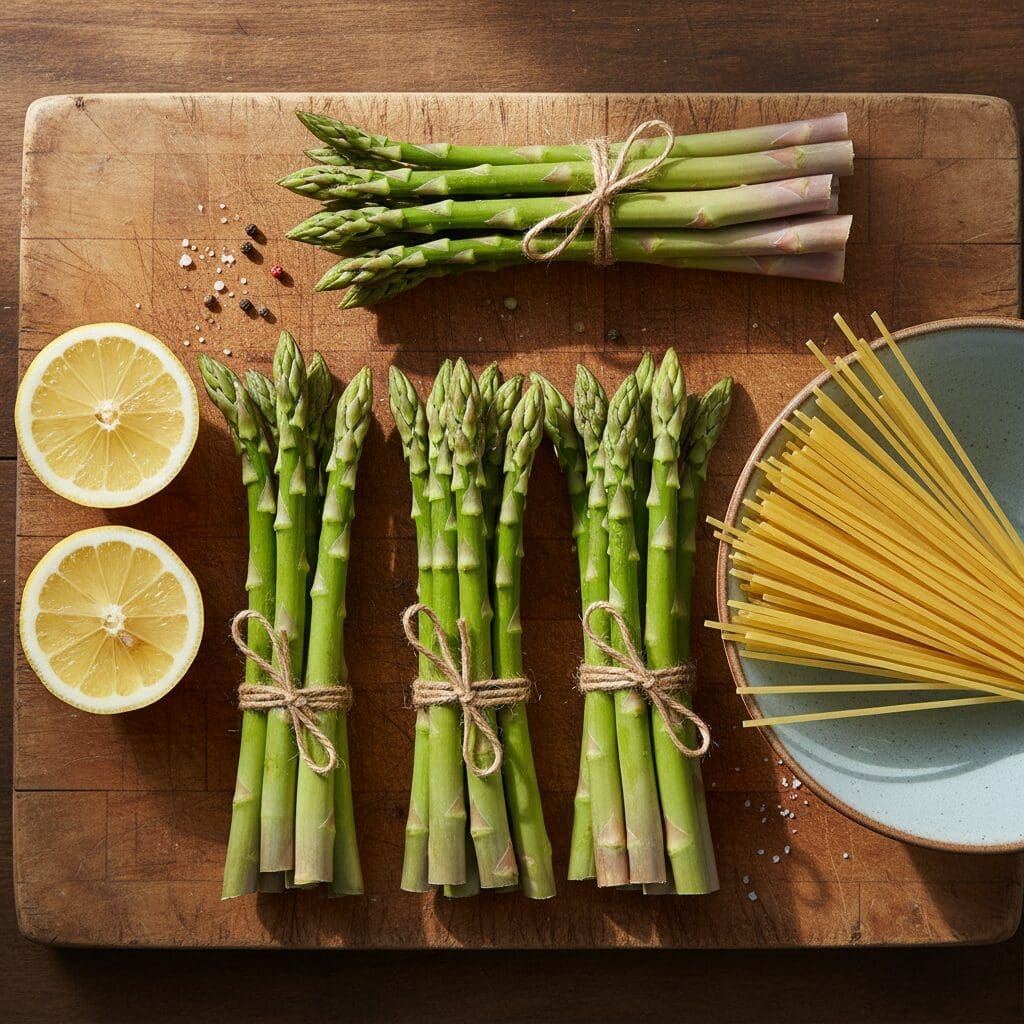
Store leftovers in an airtight container in the fridge for up to 3 days—the sauce may thicken, so add a splash of milk when reheating. For freezing, portion into bags for up to 2 months; thaw overnight and reheat gently on the stovetop with extra liquid to revive creaminess.
Microwave in short bursts, stirring midway, but stovetop preserves texture best. Make-ahead: Prep sauce and veggies a day early, then cook pasta fresh to avoid sogginess.
This extends the recipe’s utility for meal prep, saving time mid-week.
Frequently Asked Questions
Can I use frozen asparagus?
Yes, but thaw and pat it dry first to avoid a watery sauce—add it with the pasta for the last 2 minutes of cooking.
Is this recipe kid-friendly?
Absolutely. The mild lemon flavor is approachable, and you can omit the red pepper flakes for sensitive palates.
What if I don’t have vegan parmesan?
Nutritional yeast offers a cheesy, savory flavor. You can also use a sprinkle of toasted breadcrumbs for texture.
Can I make it oil-free?
You can sauté the garlic in a bit of pasta water instead of oil, though this may slightly alter the final creaminess of the sauce.
How do I know when the sauce is thick enough?
It should be thick enough to cling to the noodles without being soupy. A good test is if it coats the back of a spoon. Aim for it to reduce by about 20% while simmering.
These answers address common queries, helping you confidently recreate the dish.
Conclusion
This vegan lemon asparagus pasta is more than a recipe—it’s a celebration of spring’s bounty, blending ease with elegance for meals that nourish body and soul. With its quick prep, customizable nature, and fresh flavors, it’s set to become a staple in your rotation.
Experiment with the variations, savor the process, and enjoy the compliments. For more plant-based inspiration, explore my other recipes like Air Fryer Asparagus or Creamy Lemon Tofu.
Happy cooking!
